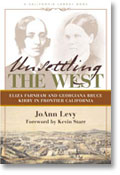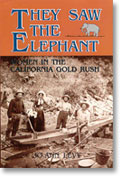The
Intrepid Females of Forty-Nine
JoAnn
Levy
Note, historic
photos are randomly placed and are not associated with
any person or persons in this article. The two actresses: Lola
Montez, and Lotta Crabtree are correctly depicted.
In
1849, by conservative estimates, 25,000 people crossed the plains
to California . The number arriving that year by sea, from around
the Horn and across the Isthmus, exceeded 30,000 . This immense
migration traveling beneath the canvas of covered wagons and
the canvas of sails included many surprisingly adventurous women.
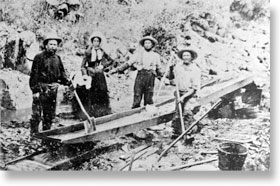 One
of them was Mary Jane Megquier who crossed the Isthmus early
in 1849, and wrote this of her Chagres River journey:
One
of them was Mary Jane Megquier who crossed the Isthmus early
in 1849, and wrote this of her Chagres River journey:
“The birds singing monkeys screeching the Americans laughing
and joking the natives grunting as they pushed us along through
the rapids was enough to drive one mad with delight.”
She cheerfully described the sights, including the church at
Gorgona, which was “overrun with domestic animals in time
of service…. A mule took the liberty to depart this life
within its walls while we were there, which was looked upon
by the natives of no consequence.”
Mrs. Megquier took to travel like a duck to water. On
a later trip, after visiting family in Maine, she returned to
San Francisco via Nicaragua, without her husband, but in company
with two women. She breezily wrote from Nicaragua:
“We spent three days very pleasantly although all were
nearly starved for the want of wholesome food but you know my
stomach is not lined with pink satin the bristles on the pork,
the weavels in the rice and worms in the bread did not start
me at all, but I grew fat upon it. Emily, Miss Bartlett and
myself had a small room with scarce light enough to see the
rats and spiders…”
Lucilla Brown, a more critical traveler, crossed the Isthmus
late in 1849, in a company that included “seven females.”
She intentionally did not write ladies, “for all do not
deserve the name.”
Among those acceptable to her was John Sutter’s
family. Since they were Swiss, Mrs. Brown could converse little
with them, but of the remaining women passengers Mrs. Brown
had decided opinions:
“There is a Mrs. Brayner, an upholsterer by trade, going
on to meet her husband in San Francisco. A Miss Scott, about
fifty years old, going independent and alone, to speculate in
California – of course, no very agreeable person. Then
there is a Mrs. Taylor, whose husband left her some years ago—is
said to have a father in California, whither she purports to
be bound. She is young and has some pretentions to beauty, and
at first commanded sympathy and attention from the gentlemen;
but they all left her except the keeper of the hotel at Chagres,
a low fellow, who retains her at his lodgings there, and it
is to be hoped she will proceed no further.”
Women who crossed to California by land also noted the presence
of other women. Catherine Haun, whose party took the Lassen
route in 1849, wrote that her caravan had “a good many
women and children.”
Among forty-niners traveling the southern route through present-day
New Mexico and Arizona into San Diego was a woman with the wonderful
name of Louisiana Strentzel, who met eight families in just
one party on this road.
No stranger to gold fever, Mrs. Strentzel wrote from San Diego
to her family back home that the latest news from the mines
was that “gold is found in 27-pound lumps.” She
also wrote that her husband hadn’t been sick a day since
they left, and their two children were red and rosy and outgrowing
their clothes. She, herself, she wrote, never enjoyed better
health in her life.
Good health was noted by many women on the trails, who enjoyed
the invigorating exercise.
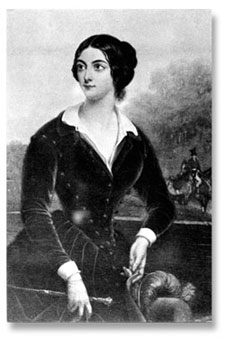 |
Lola
Montez
Eliza Rosanna Gilbert, born in Grange, County Sligo, Ireland
on February 17, 1821 was better known by her stage name
Lola Montez. the Irish-born dancer and actress
became famous as the mistress of King Ludwig I of Bavaria.
In 1846, she traveled to Munich, where she was discovered
by Ludwig I of Bavaria. Ludwig made her Countess of Landsfeld.
During the Bavarians’ revolt, Ludwig abdicated, and
Lola fled Bavaria for the United States.
From 1851 to 1853 she performed as a dancer and actress
in the eastern United States, then moved to San Francisco
in May 1853, where she married Patrick Hull and moved to
Grass Valley, California.
Lola contracted pneumonia and passed away on January 17,
1861, one month short of her fortieth birthday. |
Others noted
the novelty of the landscape, like Harriet Ward, a grandmother:
“The scenery through which we are constantly passing is
so wild and magnificently grand that it elevates the soul from
earth to heaven and causes such an elasticity of mind that I
forget I am old.”
And Lucena Parsons wrote in her diary:
“At the bottom of this valley are some very singular rocks.
It appears sublime to me to see these rocks towering one above
the other & lifting their majestick heads here in this solitary
spot. Oh, beautiful is the hand of nature.”
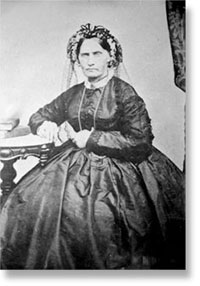 Lucena’s
journal was not otherwise a happy record. Lucena was a grave
counter. Few of her journal entries failed to mention at least
one. In all, she counted more than 380 graves while crossing
the plains. So commonplace was the face of death by the time
her party reached Fort Laramie that she sandwiches mention of
it casually between other observations:
Lucena’s
journal was not otherwise a happy record. Lucena was a grave
counter. Few of her journal entries failed to mention at least
one. In all, she counted more than 380 graves while crossing
the plains. So commonplace was the face of death by the time
her party reached Fort Laramie that she sandwiches mention of
it casually between other observations:
“It seems like home again to meet so many on the road.
We did not look for it in this wild country. I found the skull
of a man by the roadside. I took it on & buried it at the
point. There is a blacksmiths shop here for the accomodation
of emigrants kept by a French man.”
Death was far less a casual matter by the time overlanders reached
the dreaded desert. The especial cruelty of the long trek west
was that the easy part came first. The rolling grasslands of
the prairies, encountered in the springtime when people and
stock were fresh, should have come last, not mountains to climb
when food, animals, and spirit were exhausted. These mountains,
the rugged Sierra Nevada, formed the final obstacle to California’s
golden promises. They took their toll in wagons smashed and
abandoned. There were accidents. But, unless trapped by snow,
emigrants had little fear of failing to cross the Sierra. Not
so, the hot, dry 40-mile gauntlet of desert lying between the
Humbolt River and the Carson or Truckee rivers flowing from
the eastern Sierra.
By the time overlanders approached this final desert, they and
their animals had plodded and slogged and climbed and descended
nearly 2,000 miles. In a meadow near the Humboldt River’s
sink, the travel-weary emigrants cut grass for their worn and
thin mules and oxen, dried as much as they could carry, and
hurried on. There was no forage on the desert’s final
40 miles
Few passages of women’s diaries and letters are
more poignant than those recording this desert crossing. Sallie
Hester’s 1849 diary entry is eloquent testimony to the
hardship:
“Stopped and cut grass for the cattle and supplied ourselves
with water for the desert. Had a trying time crossing. Several
of our cattle gave out, and we left one. Our journey through
the desert was from Monday, three o’clock in the afternoon,
until Thursday morning at sunrise, September 6. The weary journey
last night, the mooing of the cattle for water, their exhausted
condition, with the cry of “Another ox down,” the
stopping of the train to unyoke the poor dying brute, to let
him follow at will or stop by the wayside and die, and the weary,
weary tramp of men and beasts, worn out with heat and famished
for water, will never be erased from my memory. Just at dawn,
in the distance, we had a glimpse of the Truckee River, and
with it the feeling: Saved at last!”
Another 49er
family, Josiah and Sarah Royce, with their two-year-old daughter
Mary, crossed the Carson River in October. To avoid the heat,
they traveled the desert at night. In the dark, they missed
the fork to the meadows and its precious grass. Far upon the
desert, they realized the mistake. Sarah’s recollection
of that moment never faded:
“So there was nothing to be done but turn back and try
to find the meadows. Turn back! What a chill the words sent
through one. Turn back, on a journey like that; in which every
mile had been gained by most earnest labor, growing more and
more intense, until, of late, it had seemed that the certainty
of advance with every step was all that made the next step possible.
And now, for miles, we were to go back. In all that long journey
no steps ever seemed so heavy, so hard to take, as those with
which I turned my back to the sun that afternoon of October
4, 1849.”
Most overland emigrants on the California Trail kept to the
tried and true Carson and Truckee routes, but every rumor of
a faster, easier way found an ear anxious to believe. At the
Humboldt especially, with the dreaded desert ahead and the high
mountains beyond, even the most conservative travelers considered
a convincingly proposed alternative. In 1849, thousands succumbed
to the temptation. Either through argument or the example of
the wagon ahead, much of the tail end of that year’s migration
turned north from the Humbolt for Peter Lassen’s ranch.
They succeeded only in exchanging one desert for another, while
adding 200 desperate and dangerous miles to their journey—traveling
north nearly to the Oregon border.
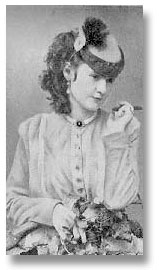 |
Lotta
Crabtree
Charlotte Mignon Crabtree was born
in 1847 in New York City to parents John Ashworth Crabtree
and Mary Ann (Livesey) Crabtree. In 1851, her father left
for San Francisco looking for gold, Lotta and her mother
followed in 1852. The family reunited in Grass Valley, California
to run a boarding house for the miners.
It was here, Lotta met actress Lola Montez and became her
protégé. Lotta made her first professional
appearance at a tavern owned by Matt Taylor. Lotta began
traveling to all of the mining camps performing ballads
and dancing for the miners. In 1856, the family moved back
to San Francisco where Lotta toured Sacramento and the Valley,
and became frequently in demand. By 1859 she had become
"Miss Lotta, the San Francisco Favorite".
Lotta retired in 1891. The profits from her career, wisely
invested in real estate all over the country during her
tours, allowed her to lead a comfortable life. At her death
in 1924 she left an estate of four million dollars. |
Catherine
Haun’s party took that road. She remembered well the hardships
“The alkali dust of this territory
was suffocating, irritating our throats and clouds of it often
blinded us. The mirages tantalized us; the water was unfit to
drink or use in any way; animals often perished or were so overcome
by heat and exhaustion that they had to be abandoned, or in
case of human hunger, the poor jaded creatures were killed and
eaten…. One of our dogs was so emaciated and exhausted
that we were obliged to leave him on this desert and it was
said that the train following us used him for food.”
No one can measure the fear and suffering endured by these people
on the Lassen route, or by those on the desert crossings to
the Truckee and Carson rivers, or on the southern trail into
San Diego. But the fear and suffering of emigrants on another
route into California could not have been surpassed.
In October of 1849, from a camp south of Salt Lake City, more
than 300 people followed Jefferson Hunt, a guide familiar with
the Old Spanish Trail to Los Angeles. A pack train overtook
them, and in it was a man with a map showing a cutoff from this
trail. The tantalizing prospect of short-cut immediately danced
in the minds of impatient emigrants. The temptation was too
much for a Methodist minister named John Brier, who fired others
with his zeal for the cutoff. Although Jefferson Hunt refused
to take it, on November 4, 1849, approximately 27 wagons did.
Among them were four families, including the Briers. Their path
took them into a vast and desolate desert, a hellhole they would
name Death Valley.
Thirty-four men, mostly young and mostly from Illinois, calling
themselves Jayhawkers, entered the desert valley. Three of them
died there. The Rev. Mr. Brier, his wife Juliet, and their three
young sons followed the Jayhawkers in a desperate search for
a way out.
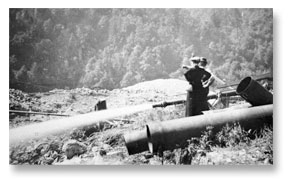 When
one young man suggested to Juliet that she and her children
remain behind and let them send back for her, she adamantly
refused:
When
one young man suggested to Juliet that she and her children
remain behind and let them send back for her, she adamantly
refused:
“I knew what was in his mind.
“No,” I said, “I have never been a hindrance,
I have never kept the company waiting, neither have my children,
and every step I take will be toward California.” Give
up! I knew what that meant: a shallow grave in the sand.”
Juliet Brier earned the Jayhawkers’ great respect and
affection, one recalling that in walking nearly a hundred miles
through sand and sharp-edged rocks that she frequently carried
one of her children on her back, another in her arms, and held
the third by the hand. At Jayhawker reunions she was spoken
of as a heroine for caring for the sick among them.
Her own recollection was modest:
“Did I nurse the sick? Ah, there
was little of that to do. I always did what I could for the
poor fellows, but that wasn’t much. When one grew sick
he just lay down, weary like, and his life went out. It was
nature giving up. Poor souls!”
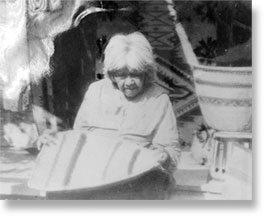 Care
for her own family consumed most of Juliet’s strength.
In one 48-hour stretch without water, her oldest boy Kirk suffered
terribly:
Care
for her own family consumed most of Juliet’s strength.
In one 48-hour stretch without water, her oldest boy Kirk suffered
terribly:
“The child would murmur occasionally,
“Oh, father, where’s the water?” His pitiful,
delirious wails were worse than the killing thirst. It was terrible.
I seem to see it all over again. I staggered and struggled wearily
behind with the other two boys and the oxen. The little fellows
bore up bravely and hardly complained, though they could barely
talk, so dry and swollen were their lips and tongue. John would
try to cheer up his brother Kirk by telling him of the wonderful
water we would find and all the good things we could get to
eat. Every step I expected to sink down and die.”
The Brier family, with much suffering, reached safety on February
12, 1850. The other three families lost in Death Valley also
survived. The Wade family celebrated deliverance on February
10. The Bennett and Arcan families, heroically rescued by two
selfless young men, escaped the valley of death on March 7….four
months and three days after their fateful decision to take the
cutoff.
The Brier family made a home in Marysville, the Wades in Alviso,
the Bennetts at Moss Landing, and the Arcans in Santa Cruz.
Captivated by the beautiful redwoods there, Abigail Arcan announced
to her husband: “You can go to the mines if you want to.
I have seen all the godforsaken country I am going to see, and
I’m going to stay right here as long as I live.”
And she did. Her first necessity, of course, like all women
new to California, was a home. California offered few comforts,
however, and almost nothing homelike.
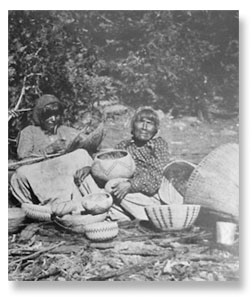 Forty-niner
Anne Booth came around the Horn in a ship she continued to live
aboard for more than a month in San Francisco’s Bay, and
wrote:
Forty-niner
Anne Booth came around the Horn in a ship she continued to live
aboard for more than a month in San Francisco’s Bay, and
wrote:
“…it is true, there are
many disadvantages and privations attending life in California;
but these I came prepared to encounter, and by no means expected
to find the comforts and refinements of home….”
In mining camps, many forty-niner women continued to live in
the wagons that brought them, which Mrs. John Berry found “very
disagreeable.”
“The rains set in early in November, and continued with
little interruption until the latter part of March and here
were we poor souls living almost out of doors. Sometimes of
a morning I would come out of the wagon and find the…shed
under which I cooked blown over & my utensils lying in all
directions, fire out & it pouring down as tho’ the
clouds had burst. Sometimes I would scold and fret, other times
endure it in mute agony…”
And how she yearned for a comfortable bed
“Oh! you who lounge on your divans
& sofas, sleep on your fine, luxurious beds…know nothing
of the life of a California emigrant. Here are we sitting on
a pine block…sleeping in beds with either a quilt or a
blanket as substitute for sheets (I can tell you it is very
aristocratic to have a bed at all)”….
In towns, of course, were hotels – if one stretched the
definition. The celebrated St. Francis Hotel of San Francisco
opened in 1849 and was so high class even then that it boasted
it offered sheets on its beds. No other hotel did.
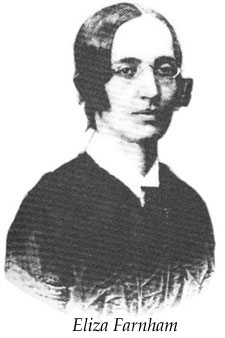 A
reminiscence of a lady guest from those early days confirms
that her bed there was “delightful.” Two “soft
hair mattresses” and “a pile of snowy blankets”
hastened her slumbers, which were soon interrupted:
A
reminiscence of a lady guest from those early days confirms
that her bed there was “delightful.” Two “soft
hair mattresses” and “a pile of snowy blankets”
hastened her slumbers, which were soon interrupted:
“I was suddenly awakened by voices,
as I thought, in my room; but which I soon discovered came from
two gentlemen, one on each side of me, who were talking to each
other from their own rooms through mine; which, as the walls
were only of canvas and paper, they could easily do. This was
rather a startling discovery, and I at once began to cough,
to give them notice of my interposition, lest I should become
an unwilling auditor of matters not intended for my ear. The
conversation ceased, but before I was able to compose myself
to sleep again…a nasal serenade commenced, which, sometimes
a duet and sometimes a solo, frightened sleep from my eyes….”
A 49er woman living in Santa Cruz knew about thin walls, too.
She was Eliza Farnham, a widow who had come round the Horn with
two children and a woman friend to claim property left by Eliza’s
late husband.
She described the ‘casa’ she inherited on
her Santa Cruz ranch, as:
“Not a cheerful specimen, even
of California habitations—being made of slabs, were originally
placed upright, but which have departed sadly from the perpendicular
in every direction….”
Mrs. Farnham focused her initial housekeeping wants on simply
getting a stove installed. During the three-day period that
Eliza called the ‘siege of the stove,’ a hired man
failed at the task, as did her friend Miss Sampson. Then Eliza
tackled it:
“On the third day, it was agreed that stoves could not
have been used in the time of Job, or all his other afflictions
would have been unnecessary.”
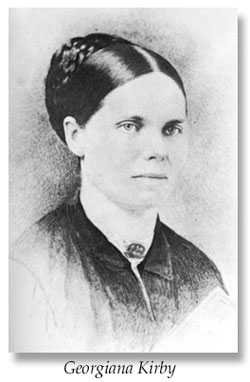 Not
afraid of labor, Mrs. Farnham set herself the task of building
a new house:
Not
afraid of labor, Mrs. Farnham set herself the task of building
a new house:
“My first participation in the
labor of its erection was the tenanting of the joists and studding
for the lower story, a work in which I succeeded so well, that
during its progress I laughed, when I paused for a few moments
to rest, at the idea of promising to pay a man $14 or $16 per
day for doing what I found my own hands so dexterous in.”
Eliza Farnham, who conquered a stove, built a house, and put
her Santa Cruz land to growing potatoes, quickly recognized
that women in California would have to work.
And indeed 49er women did work. Some even mined. A newspaper
editor saw a woman at Angel’s Creek dipping and pouring
water into the gold washer her husband rocked. The editor reported
that she wore short boots, white duck pantaloons, a red flannel
shirt, with a black leather belt and a Panama hat.
Louise Clappe tried her hand at digging gold, too:
“I have become a mineress; that
is, if the having washed a pan of dirt with my own hands, and
procured therefrom three dollars and twenty-five cents in gold
dust…will entitle me to the name. I can truly say, with
the blacksmith’s apprentice at the close of his first
day’s work at the anvil, ‘I am sorry I learned the
trade;’ for I wet my feet, tore my dress, spoilt a pair
of new gloves, nearly froze my fingers, got an awful headache,
took cold and lost a valuable breastpin, in this my labor of
love.”
An easier and more profitable avenue to gold, for most women,
was the selling of familiar domestic skills, like Abby Mansur’s
neighbor at Horseshoe Bar: “she makes from 15 to 20 dollars
a week washing…has all she wants to do so you can see
that women stand as good chance as men.”
Mary Jane Caples made pies
“My venture was a success. I sold
fruit pies for one dollar and a quarter a piece, and mince pies
for one dollar and fifty cents. I sometimes made and sold a
hundred in a day, and not even a stove to bake them in, but
had two small dutch ovens.”
One woman boasted:
“I have made about $18,000 worth
of pies—about one third of this has been clear profit.
One year I dragged my own wood off the mountain and chopped
it, and I have never had so much as a child to take a step for
me in this country. $11,000 I baked in one little iron skillet,
a considerable portion by a campfire, without the shelter of
a tree from the broiling sun.”
Another woman wrote, from San Francisco
“A smart woman can do very well
in this country—true, there are not many comforts and
one must work all the time and work hard, but there is plenty
to do and good pay. If I was in Boston now and know what I now
know of California I would come out here – if I had to
hire the money to bring me out. It is the only country I ever
was in where a woman received anything like a just compensation
for work.”
Running a boardinghouse was the commonest money-maker
for women. One woman earned $189 a week after only three weeks
of keeping boarders in the mines. She shared with her boarders
accommodations decidedly minimal, as she wrote her children
back East:
“We have one small room about
14 feet square, and a little back room we use for a storeroom
about as large as a piece of chalk. Then we have an open chamber…
divided off by a cloth. The gentlemen occupy one end, Mrs. H
and daughter, your father and myself, the other. We have a curtain
hung between our beds but we do not take pains to draw it, as
it is of no use to be particular here.”
Luzena Wilson set herself up in the boardinghouse business,
too. Despite its rustic beginnings, she had grand plans for
her Nevada City enterprise, which she elevated with the title
‘hotel’:
“I bought two boards from a precious
pile belonging to a man who was building the second wooden house
in town. With my own hands I chopped stakes, drove them into
the ground, and set up my table. I bought provisions at a neighboring
store, and when my husband came back at night he found 20 miners
eating at my table. Each man as he rose put a dollar in my hand
and said I might count him a permanent customer. I called my
hotel ‘El Dorado.’”
But running a boardinghouse was hard work, as Mary Jane
Megquier attested from San Francisco:
“I should like to give you an
account of my work if I could do it justice. I get up and make
the coffee, then I make the biscuit, then I fry the potatoes
and broil 3 pounds of steak, and as much liver, while the hired
woman is sweeping and setting the table. At 8 the bell rings
and they are eating until nine. I do not sit until they are
nearly all done…after breakfast I bake 6 loaves of bread
(not very big) then 4 pies or a pudding, then we have lamb,
for which we have paid $9 a quarter, beef, pork, baked turnips,
beets, potatoes, radishes, salad, and that everlasting soup,
every day, dine at 2, for tea we have hash, cold meat, bread
and butter, sauce and some kind of cake and I have cooked every
mouthful that has been eaten excepting one day when we were
on a steamboat excursion. I make 6 beds every day and do the
washing and ironing and you must think I am very busy and when
I dance all night I am obliged to trot all day and if I had
not the constitution of 6 horses I should have been dead long
ago but I am going to give up in the fall, as I am sick and
tired of work.”
In full agreement was Mary Ballou, who kept a boardinghouse
in the mines. Her complaints included the additional inconvenience
of unwelcome animals.
“Anything can walk into the kitchen and then from the
kitchen into the dining room so you see the hogs and mules can
walk in any time, day or night, if they choose to do so. Sometimes
I am up all times a night scaring the hogs and mules out of
the house. I made a blueberry pudding today for dinner. Sometimes
I am making soups and cranberry tarts and baking chicken that
cost $4 a head and cooking eggs at $3 a dozen. Sometimes boiling
cabbage and turnips and frying fritters and broiling steak and
cooking codfish and potatoes. Sometimes I am taking care of
babies and nursing at the rate of $50 a week but I would not
advise any Lady to come out here and suffer the toil and fatigue
that I have suffered for the sake of a little gold.”
One
woman determined to get her gold the old-fashioned way, by marrying
it. She placed what must have been the first personals ad in
a California newspaper, under the head:
A Husband Wanted...
By a lady who can wash, cook, scour, sew, milk, spin, weave,
hoe (can’t plow), cut wood, make fires, feed the pigs,
raise chickens, rock the cradle, (gold rocker, I thank you,
Sir!), saw a plank, drive nails, etc. These are a few of the
solid branches; now for the ornamental. “long time ago”
she went as far as syntax, read Murray’s Geography and
through two rules in Pike’s Grammar. Could find 6 states
on the atlas. Could read, and you can see that she can write.
Can—no, could—paint roses, butterflies, ships, etc.
Could once dance; can ride a horse, donkey or oxen…Oh,
I hear you ask, could she scold? No, she can’t you _____________good-for-nothing
_________!
Now for her terms. Her age is none of your business. She is
neither handsome nor a fright, yet an old man need not apply,
nor any who have not a little more education than she has, and
a great deal more gold, for there must be $20,000 settled on
her before she will bind herself to perform all the above. Address
to Dorothy Scraggs, with real name. P.O. Marysville.”
Of course there were all kinds of ways
women could earn a ‘little gold,’ and they did.
Catherine Sinclair managed a theatre. A French woman barbered.
Julia Shannon took photographs. Sophia Eastman was a nurse.
Mrs. Pelton taught school. Mrs. Phelps sold milk. Mary Ann Dunleavy
operated a 10-pin bowling alley. Enos Christman witnessed the
performance of a lady bullfighter. Franklin Buck met a Spanish
(“genuine Castillian”) woman mulepacker. Charlotte
Parkhurst drove a stage for Wells Fargo. Mrs. Raye acted in
the theatre. Mrs. Rowe performed in a circus, riding a trick
pony named Adonis.
And some women danced, some sang, some played musical instruments,
some dealt cards, some poured drinks. What readily comes to
mind with the subject of gold rush women are these saloon girls
and parlor house madams. And who were these so-called soiled
doves? They were Chilean, Mexican, Chinese, French, English,
Irish, and American. No stereotype encompasses them all, for
they and their experiences were as diverse as the population.
A few were phenomenally successful, most merely survived. Despite
popular 19th century assumption that women were driven into
prostitution by seduction and abandonment, most pursued the
profession for economic reasons.
Among the first, believed to have arrived in San Francisco in
1849, was a Chinese woman named Ah Toy. She was a ‘daughter
of joy,’ the Chinese expression for prostitute, but she
was more than that. She was an extraordinary woman. First, she
was independent of any man, Chinese or Caucasian, remarkable
for an Asian woman. Second, she spoke English, also most unusual
for a Chinese woman. Third, she was assertive and intelligent,
for she quickly learned to use the American judicial system,
regularly taking her grievances to court.
Obviously, she was adventurous, determined, hardworking, bright,
independent, aggressive—the very qualities of a successful
49er.
She shared those qualities with thousands of pioneering women
who demonstrated the courage and determination required by the
unique circumstances of gold rush California.
And yet when most people think about 49ers, they think of them
as men. And yet, women – women with gold fever like Louisiana
Strentzel, suffering overlanders like Sarah Royce and Juliet
Brier and Catherine Haun, the boardinghouse keepers like Mary
Ballou and Luzena Wilson and Mary Jane Megquier, potato growers
like Eliza Farnham, the pie makers, the washerwomen, the seamstresses,
prostitutes, actresses, circus riders, nurses, teachers, wives,
mothers, sisters, and daughters – women were 49ers, too.
To Learn more about
the author and her books click on a book below...
About the
Author
JoAnn Levy has been writing about California’s gold-rushing
women for more than twenty years and is the author of the now-classic
They Saw the Elephant: Women in the California Gold Rush. Her
first fiction, Daughter of Joy, A Novel of Gold Rush San Francisco,
won the 1999 Willa Award for Best Historical Fiction. A second
novel, For California’s Gold, captured the prize in 2001,
after debuting at the National Archives in Washington, D.C.,
where Levy spoke in honor of Women’s History Month and
California’s statehood sesquicentennial.
Just released is a “biographical gem,” Unsettling
the West: Eliza Farnham and Georgiana Bruce Kirby in Frontier
California, in which Levy recounts the lives and adventures
of two remarkable women, pioneer reformers who touched history
and made history.
A frequent speaker on behalf of the gold-rushing women she discovered
in nearly a decade of research, Levy has been featured in numerous
TV documentaries.
Visit JoAnn's webstie at: http://www.goldrush.com/~joann/index.html
Unruh, John D., Jr., The Plains
Across (Urbana: University of Illinois Press, 1982), p. 85.
Holliday, J. S., Rush for Riches (Berkeley: University of California
Press, 1999), p. 94.
Megquier, Mary Jane, Apron Full of Gold: The Letters of Mary
Jane Megquier from San Francisco, 1849-1856, ed. Robert Glass
Cleland (San Marino, Calif.: Huntington Library, 1949), Letter
dated Panama, May 14, 1849.
Ibid., Letter dated November 4, 1855. Brown, Lucilla Linn, “Pioneer
Letters,” ed. Gaylord A. Beaman, Historical Society of
Southern California Quarterly (March 1939), pp. 18-26. Haun,
Catherine, “A Woman’s Trip Across the Plains, 1849.”
In Women’s Diaries of the Westward Journey, by Lillian
Schlissel (New York: Schocken Books, 1982), p. 170. Strentzel,
Louisiana, “Letter from San Diego, 1849.” In Covered
Wagon Women, Vol. 1, ed. Kenneth L. Holmes (Glendale, Calif.:
Arthur H. Clark Co., 1983), p. 250. Ward, Harriet S., Prairie
Schooner Lady: The Journal of Harriet Sherrill Ward, 1853, eds.
Ward G. and Florence Stark DeWitt (Los Angeles: Westernlore
Press, 1959), p. 132. Parsons, Lucena, “The Journal of
Lucena Parsons.” In Covered Wagon Women, Vol. 2, ed. Kenneth
L. Holmes (Glendale, Calif.: Arthur H. Clark Co., 1983), p.
247. Hester, Sallie, “The Diary of a Pioneer Girl.”
In Covered Wagon Women, Vol. 1, ed. Kenneth L. Holmes (Glendale,
Calif.: Arthur H. Clark Co., 1983), p. 244. Royce, Sarah, A
Frontier Lady: Recollections of the Gold Rush and Early California
(New Haven, Conn.: Yale University Press, 1977), p. 248. Haun,
op. cit., p. 182. Journals of Forty-Niners: Salt Lake to Los
Angeles, ed. LeRoy R. and Ann W. Hafen (Glendale, Calif.: The
Arthur H. Clark Co., 1954), p. 38. Wheat, Carl I., “The
Forty-Niners in Death Valley: A Tentative Census,” Historical
Society of Southern California Quarterly, December 1939. Belden,
L. Burr, Death Valley Heroine: And Source Accounts of the 1849
Travelers (San Bernardino, Calif.: Inland Printing & Engraving
Co., 1954), p. 21ff. Ibid., p. 27. Latta, Frank, Death Valley
‘49ers (Santa Cruz, Calif.: Bear State Books, 1979), p.
200. Ibid., p. 306. Ibid., p. 260. Booth, Anne Willson, “Journal
of a Voyage from Baltimore to San Francisco…, 1849.”
Ms. diary, The Bancroft Library, University of California, Berkeley,
p. 234. Mrs. John Berry, “A Letter from the Mines,”
California Historical Society Quarterly, Vol. V (1927), p. 293.
“Reminiscence of San Francisco, in 1850,” by Francesca,
in The Pioneer, ed. F. C. Ewer, Vol. 1, January 1854. Farnham,
Eliza W., California In-Doors and Out (New York: Dix, Edwards
& Co., 1856), p. 42. Ibid., p. 56. Ibid., p. 107. Alta California,
December 14, 1850. Clappe, Louise Amelia Knapp Smith, The Shirley
Letters from the California Mines, 1851-1852, ed. Marlene Smith-Baranzini
(Berkeley: Heyday Books), p. 68. Mansur, Abby. “Ms. Letters
Written to Her Sister, 1852-1854,” in Let Them Speak for
Themselves: Women in the American West 1849-1900 ed. Christiane
Fischer (Hamden, Conn.: Archon Books, 1977), p. 56. Caples,
Mrs. James. “Overland Journey to California,” unpublished
ms., California State Library, Sacramento. California Emigrant
Letters, ed. Walker D. Wyman (New York: Bookman Associates,
1971), p. 149. Letter to Catherine Oliver, 1850. Manuscripts
collection, California Historical Society, San Francisco. California
Emigrant Letters, op.cit., p. 147. Wilson, Luzena, Luzena Stanley
Wilson, ‘49er (Oakland: The Eucalyptus Press, Mills College,
1937), p. 27. Megquier, op.cit., Letter dated June 30, 1850.
Ballou, Mary B., “I Hear the Hogs in My Kitchen –
A Woman’s View of the Gold Rush” in Let Them Speak
for Themselves: Women in the American West 1849-1900 ed. Christiane
Fischer (Hamden, Conn.: Archon Books, 1977), p. 43. Quoted in:
Jackson, Joseph H., Anybody’s Gold: The Story of California’s
Mining Towns (New York: D. Appleton-Century Co., 1941), p. 101.
Gagey, Edmond M., The San Francisco Stage: A History (New York:
Columbia University Press, 1950), p. 38. Alta California, April
3, 1851. Alta California, January 29, 1850. Eastman, Sophia,
Letters. Maria M. Eastman Child Collection, The Bancroft Library,
University of California, Berkeley. Farnham, op.cit., 275. Ferguson,
Charles D., California Gold Fields (Oakland: Biobooks, 1948),
p. 103. Comstock, David A., Gold Diggers & Camp Followers:
The Nevada County Chronicles 1845-1851 (Grass Valley, Calif.:
Comstock Bonanza Press, 1982), p. 322. Christman, Enos, One
Man’s Gold: The Letters & Journal of a Forty-Niner,
ed. Florence Morrow Christman (New York: McGraw-Hill Book Co.,
1930), p. 198. Buck, Franklin A., A Yankee Trader in the Gold
Rush (Boston: Houghton Mifflin Co., 1930), p. 126. Curtis, Mabel
Rowe, The Coachman Was a Lady (Watsonville, Calif.: The Pajaro
Valley Historical Association, n.d.). Davis, W. N., Jr., “Research
Uses of County Court Records, 1850-1879, And Incidental Intimate
Glimpses of California Life and Society,” California Historical
Quarterly Vol. LII, No. 3, p. 255. Rowe, Joseph A., California’s
Pioneer Circus: Memoirs and Personal Correspondence Relative
to the Circus Business Through the Gold Country in the ‘50s,
ed. Albert Dressler (San Francisco: H. S. Crocker Co., 1926).
Sanger, William W., M.D., The History of Prostitution (New York:
Eugenics Publishing Co., 1937), p. 488. Alta California, March
6, 8, 1851; July 1, 1851; December 14, 24, 1851; December 11,
1852

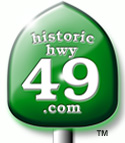
 One
of them was Mary Jane Megquier who crossed the Isthmus early
in 1849, and wrote this of her Chagres River journey:
One
of them was Mary Jane Megquier who crossed the Isthmus early
in 1849, and wrote this of her Chagres River journey:
 Lucena’s
journal was not otherwise a happy record. Lucena was a grave
counter. Few of her journal entries failed to mention at least
one. In all, she counted more than 380 graves while crossing
the plains. So commonplace was the face of death by the time
her party reached Fort Laramie that she sandwiches mention of
it casually between other observations:
Lucena’s
journal was not otherwise a happy record. Lucena was a grave
counter. Few of her journal entries failed to mention at least
one. In all, she counted more than 380 graves while crossing
the plains. So commonplace was the face of death by the time
her party reached Fort Laramie that she sandwiches mention of
it casually between other observations:
 When
one young man suggested to Juliet that she and her children
remain behind and let them send back for her, she adamantly
refused:
When
one young man suggested to Juliet that she and her children
remain behind and let them send back for her, she adamantly
refused: Care
for her own family consumed most of Juliet’s strength.
In one 48-hour stretch without water, her oldest boy Kirk suffered
terribly:
Care
for her own family consumed most of Juliet’s strength.
In one 48-hour stretch without water, her oldest boy Kirk suffered
terribly: Forty-niner
Anne Booth came around the Horn in a ship she continued to live
aboard for more than a month in San Francisco’s Bay, and
wrote:
Forty-niner
Anne Booth came around the Horn in a ship she continued to live
aboard for more than a month in San Francisco’s Bay, and
wrote: A
reminiscence of a lady guest from those early days confirms
that her bed there was “delightful.” Two “soft
hair mattresses” and “a pile of snowy blankets”
hastened her slumbers, which were soon interrupted:
A
reminiscence of a lady guest from those early days confirms
that her bed there was “delightful.” Two “soft
hair mattresses” and “a pile of snowy blankets”
hastened her slumbers, which were soon interrupted:  Not
afraid of labor, Mrs. Farnham set herself the task of building
a new house:
Not
afraid of labor, Mrs. Farnham set herself the task of building
a new house:
